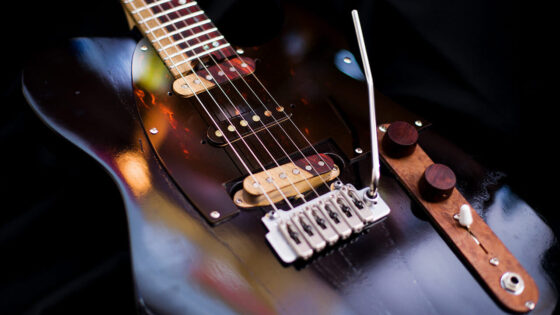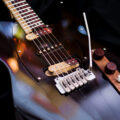Trial and error to see if active noise canceling headphones can be used for monitoring
- 2024.05.14

- 著者:Isaku
Currently, I hardly use headphones or earphones, and work with speakers instead.
The reason is that speakers feel like they place the least burden on your ears.
This article is a record of my trial and error efforts to find out whether it is possible to at least use the active noise canceling function when I absolutely have to use headphones.
These are not beyond the scope of independent research. If you are concerned about the risk of hearing loss, please consult a trusted institution such as a doctor.
目次
background
Some time ago I wrote an article about using monitor headphones for listening , but this time I’m trying to do the opposite.
A long time ago (because I was in an environment where I couldn’t really hear the speakers)oftenI was using Ultrazone open-back headphones.
When using speakers, I played the TRIO large monitor (extreme!) at a low volume.
Currently, I rarely use headphones or earphones, and instead work with a pair of near-field speakers.
This monitor speaker is useful for all types of contract video production, independent music production, and listening to music and videos.
Do headphones and earphones make your hearing less sensitive?
I feel like headphones put a lot of strain on my hearing, and when I use earphones, I end up with ringing in my ears for a while. I feel that
the closer the sound source is to my ears, the less sensitive I become to loud sounds.
I suspect that the reason headphones and earphones make it easier to detect even quiet sounds is not because the sound pressure (loudness) increases, but because humans tend to raise the volume without realizing it.
I suddenly became curious and measured the volume several times. Even if
the volume is the same perceptually , headphones are more than 6db louder than speakers 1M away, and earphones seem to be an additional 4db to 6db louder.
It is possible that people become insensitive to loud noises not because of the distance from the sound source, but because of masking caused by the noise generated by the things they wear, or the psychological effects of feeling confined.
Some earphones allow you to hear internal sounds, and a considerable amount of noise may be generated unconsciously. .
However, this is speculation, based on amateur measurements using a consumer-grade sound level meter, and has no scientific basis.
The burden on the body of headphones and earphones
In the first place, we need scientific evidence to show the harmful effects of headphones and earphones on the ears and brain, and unless that is clear, this article will be meaningless.
However, writing about it would make this page too long, so I will show it in a separate entry.
Scientific and quantitative discussions are not absolutely necessary, but they are far more useful than original research or personal impressions.
Broadly speaking, the World Health Organization (WHO) has set out guidelines for acoustic hearing loss (Making listening safe) , and it can be said that there is a very high possibility that headphones or earphones can cause hearing loss.
Do not turn the volume up to block out noisy surroundings. If you choose to listen to your portable device in a
noisy environment, use noise- canceling headphones to block out background environmental noise.Don’t turn up the volume to block out surrounding noise. If you choose to listen to your portable device in the following ways: In noisy environments, use noise-canceling headphones to block out the surrounding environmental noise.
I don’t want to use headphones if possible.
Even so, I decided to try casual active noise canceling headphones (long) to see if I could at least lower the volume a little in situations where headphones are absolutely necessary*.
If environmental sounds can be cut, it is possible to prevent the volume from increasing due to masking. And you can monitor it at a low playback volume.
*Required scenes
- Situations where the monitor speaker sound cannot be trusted (e.g. room reverberations)
- When you cannot bring your own speakers (location recording, etc.)
- When isolation of playback sound and environmental sound is required (recording, etc.)
Since there is no information in the world, you have no choice but to do trial and error yourself.
By the way, I tried attaching a binaural microphone to the M1ST’s housing to see if it could cancel noise, but it only made the noise louder.
It seems like it’s not that easy after all.
Headphone selection
Shure AONIC 50 Gen2
At first, I didn’t think too much about it and decided to try Shure’s AONIC 50 Gen2, which is said to be monitor-like .
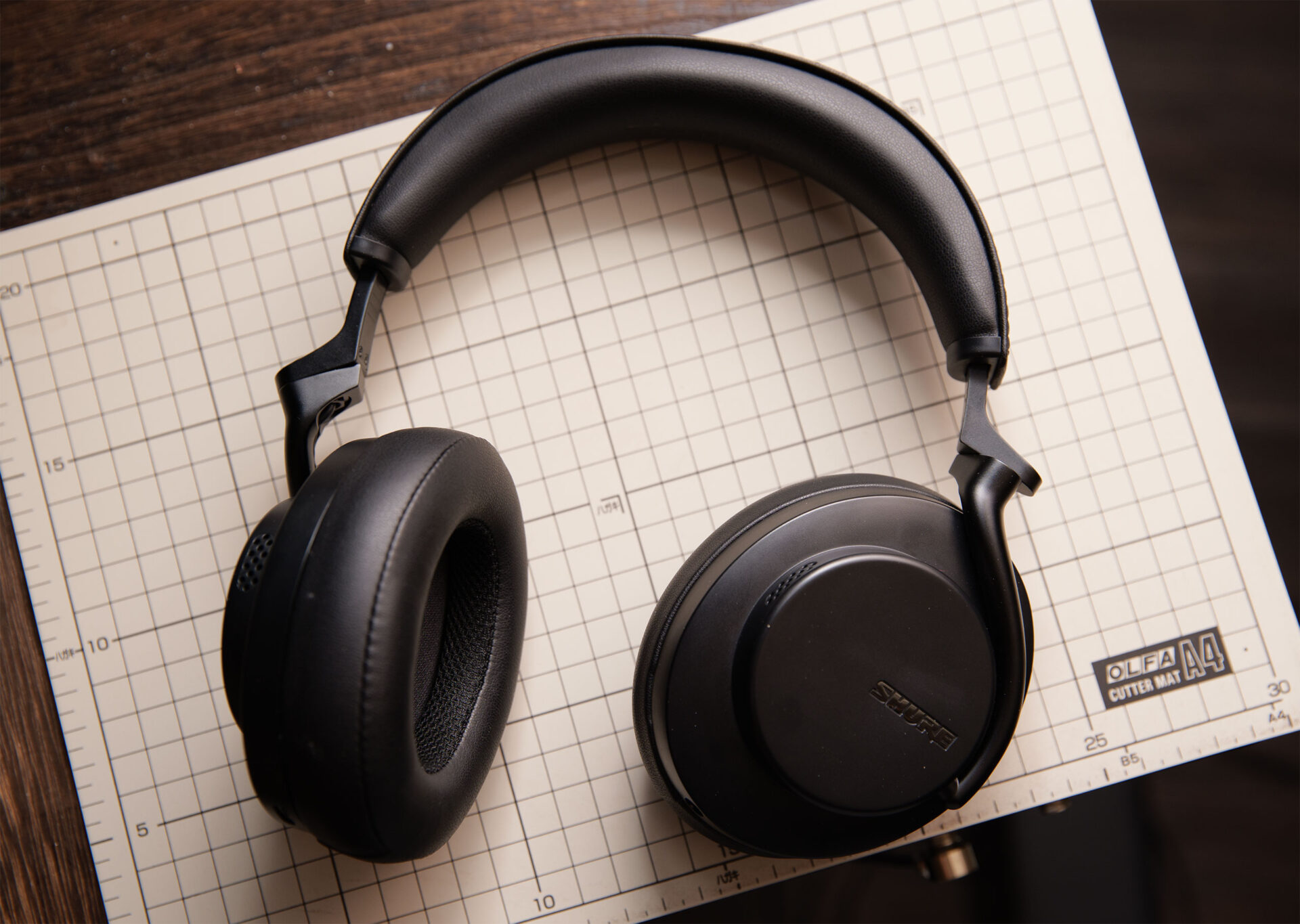
First of all, when I tried making a wired connection in a passive state, it didn’t seem as strange as I expected.
nextANCTurn on.
The spatial audio function is responsible for the strange localization, so turn it off.
Noise canceling seems to have a roughly 20db attenuation effect. ( From the measurement results of RTINGS.com )
I tried listening to the music, but it was tuned so tightly that it didn’t sound like a monitor at all.
Don’t believe what the world calls “monitor-like”.
However, when I corrected it with EQ using the app, the sound became the same as usual.
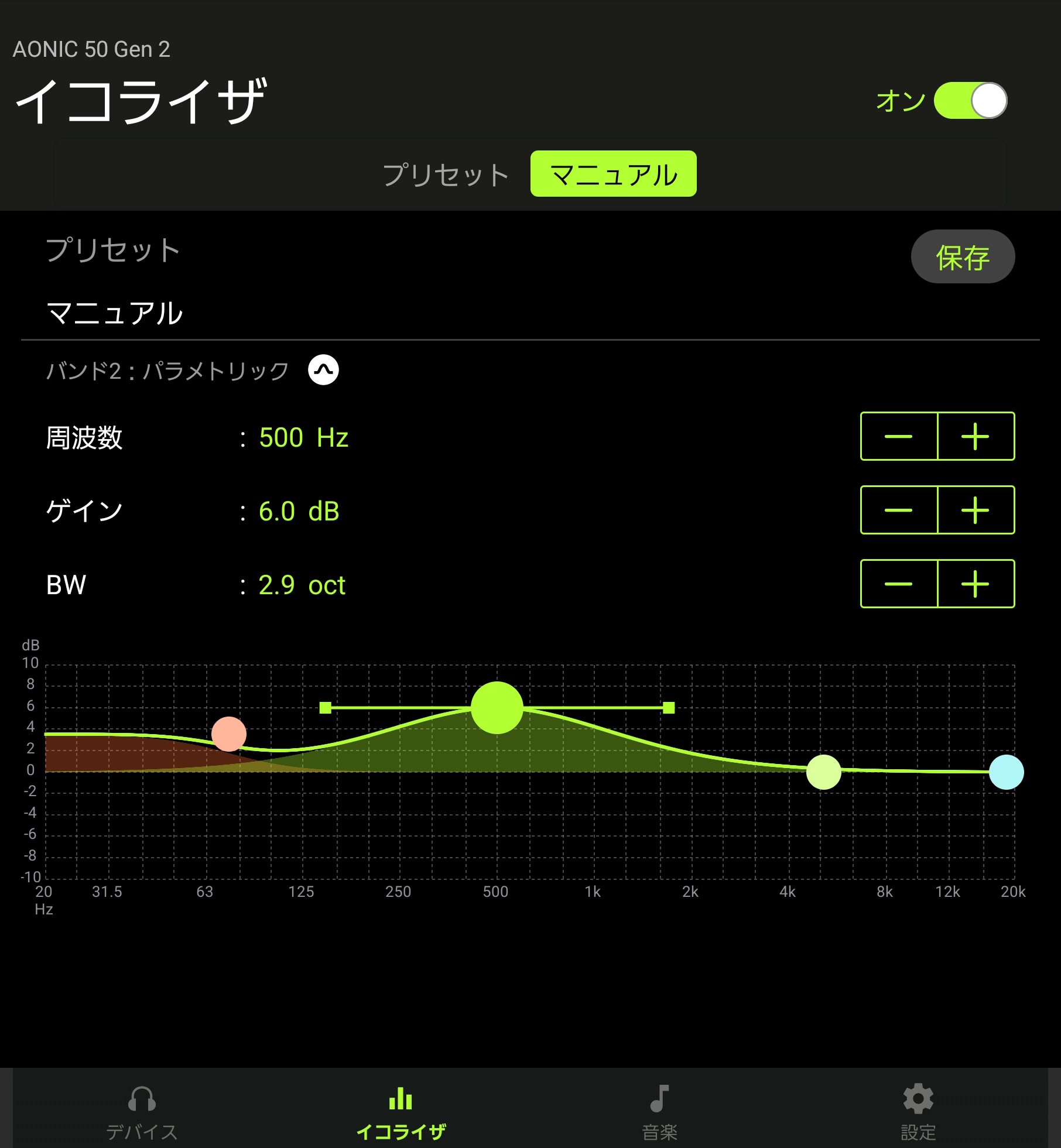
This EQ seems to be built into the main unit, and it works even when connected via wire.
I thought this would work, but when I tried monitoring the dynamic microphone’s sound collection, I noticed that there was a large delay .
The EQ is probably caused by the DSP, and it seems that it takes time to process. According to
RTINGS.com
, there seems to be a 38ms delay. This is difficult to put into practice.
SONY WH-1000XM3
So what about the Sony WH series, which RTINGS.com says has almost no delay?
I bought a SONY WH-1000XM3
and will try it out right away. This one weighs about 250g and seems light and easy to handle.
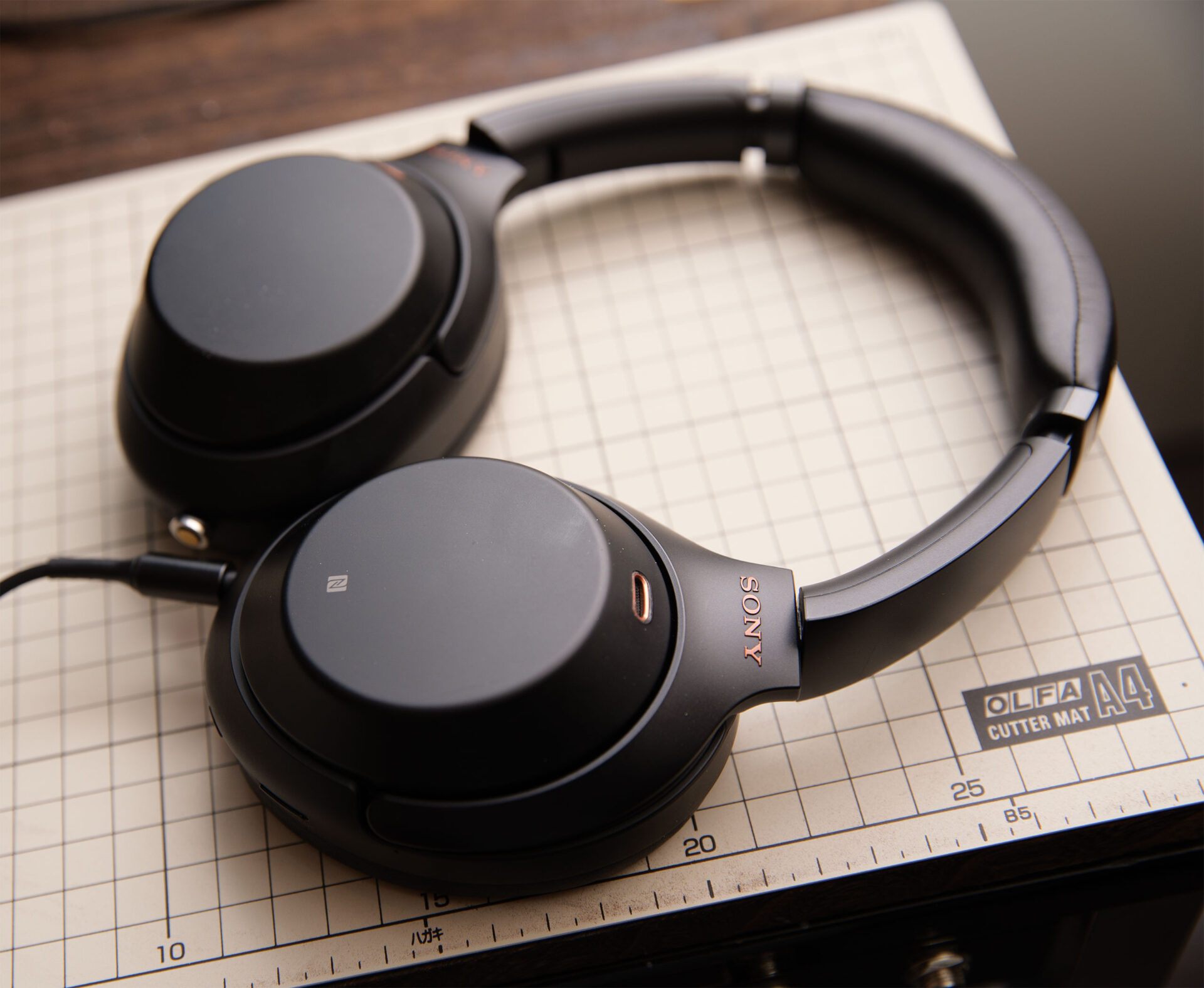
Check the sound quality – correct with EQ
Try listening to music again.
In the passive state, it makes a very sparse and strange sound.
ANCWhen I turn it on, I feel that the noise canceling is much more effective than Shure (about 27-28db attenuation).
The treble range is hardly cut, and it feels like it’s just passive sound insulation.
The low range is considerably reduced.
However, the sound quality is quite poor, with a sharp decline around 2.3k.
Try to correct it with EQ.
This does not seem to be a DSP process, and the dedicated app’s EQ is probably a software process, so it cannot be used with a wired connection.
So I use the shelving/peaking EQ on the Babyface Pro FS’s headphone output.
The question is what to target. Are you aiming for something like a Herman curve?
If you want to be more precise, you could measure the speakers you always use and use a solution that matches that.
For now, I’ll use the monitor speaker in front of me as a reference, and adjust the EQ so that the sound is audibly the same.
The frequency measurement results of the WH-1000XM3 posted on the internet are also very helpful.
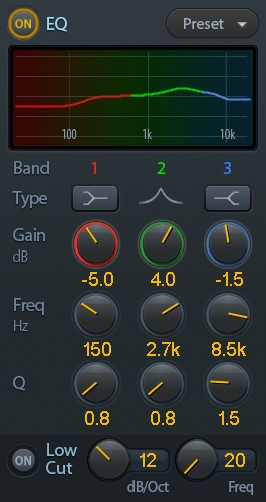
Through trial and error, I was able to create a familiar sound by adjusting the EQ.
It’s a considerable amount of correction, but for some reason it doesn’t feel too unnatural, and I feel like it’s able to reproduce the original sound quite well.
However, depending on the source, the treble range becomes vague.
Unlike the high-resolution feel of the M1ST, it sounds like monitor headphones at a slightly lower price range.
In most cases, I didn’t feel the quality was low, and I thought it was within an acceptable range.
The localization, phase, and imaging , which I thought were the biggest problems , seem to have improved considerably compared to older ANC headphones, and I don’t feel any unnaturalness.
Check the sound of the narration alone
Next, I’ll check the sound of the narration alone on the DAW.
As expected, the M1ST makes it easier to understand the details of the treble range.
However, the WH-1000XM3+EQ doesn’t produce a sound where you can’t hear any details at all.
It’s close to the sound of regular speakers, and doesn’t sound unmanageable.
The localization was better than I expected, and compared to the M1ST, I felt it was easier to understand.
In the first place, perhaps because the compared M1ST also has a wider sound field, I once again felt a slight sense of discomfort in the center localization.
I think the 900ST and 7506 were more planar and solid (I don’t have them with me right now, so I don’t know).
It seems to be fine now, but the imaging of the WH-1000XM4 and XM5 seems to be even better, so you might want to give them a try.
I also tested it at work where the air conditioning was working, and the noise canceling made it much easier to concentrate on the source sound.
This is his biggest advantage.
Raw sound phase problem
Next, I tried monitoring the sound of the dynamic microphone.
It is assumed that your own voice will be recorded.
There is no delay, but my voice becomes smaller and thinner, and it sounds like there is no center.
Active noise canceling uses a microphone attached to the headphones to pick up environmental sounds and send them out of phase to cancel out the surrounding sounds.
Your own voice is also picked up by the microphone attached to the headphones.
It seems that the user’s own voice, which has been processed in the opposite phase, and the voice collected by the dynamic microphone are canceling each other out, making it impossible to monitor his or her own voice.
The energy of the out-of-phase sound should be used up, but in reality it cannot be monitored.
For now, I pressed the phase inversion switch on the channel strip to which the dynamic microphone was connected, and I was able to hear it properly.
This time, it feels strange that my own voice through bone conduction is being canceled out a bit, but it is difficult to listen to my own voice and the sound source in complete isolation when the sound collection booth is not separated.
This seems like it could be put into practice.
You may now understand why there are almost no monitor headphones with ANC functionality
(I could only find Presonus Eris HD10BT). I think it’s because of these problems.
What about location?
By using EQ and phase switching , I was able to get it to a point where it felt like it could be put to practical use in theory.
All of this is handled by BabyfaceProFS, but it’s a problem if you can’t take Babyface out with you.
You will have to rely on something like a portable headphone amplifier with EQ, but this is rare and the major ones only have Shure SHA900.
Furthermore, there is no way that there is anything that has a phase conversion function.
In addition, originally only the phase of the source for monitoring live sound should be changed, and that problem has not been resolved.
However, I don’t think this is much of a problem for creators who are able to use their own discretion without pursuing rigor.
Portacapture X6
Tascam’s field recorder Portacapture X6 can perform these processes on microphone and line inputs.
Use this as a headphone amplifier.
It is possible to perform 4-band EQ and phase inversion for each input source, and the EQ band and Q can be adjusted.
It runs on batteries and is fairly light.
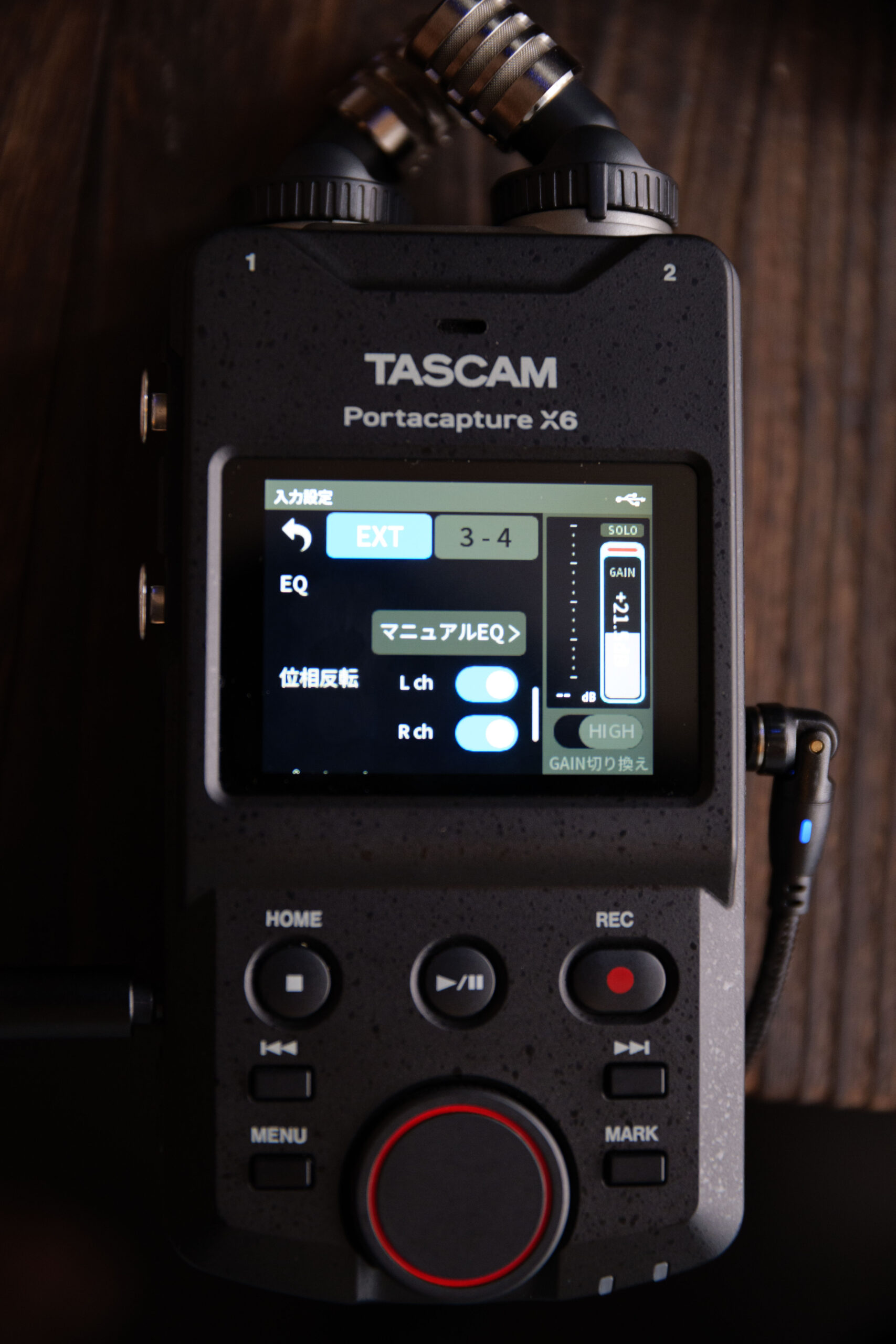
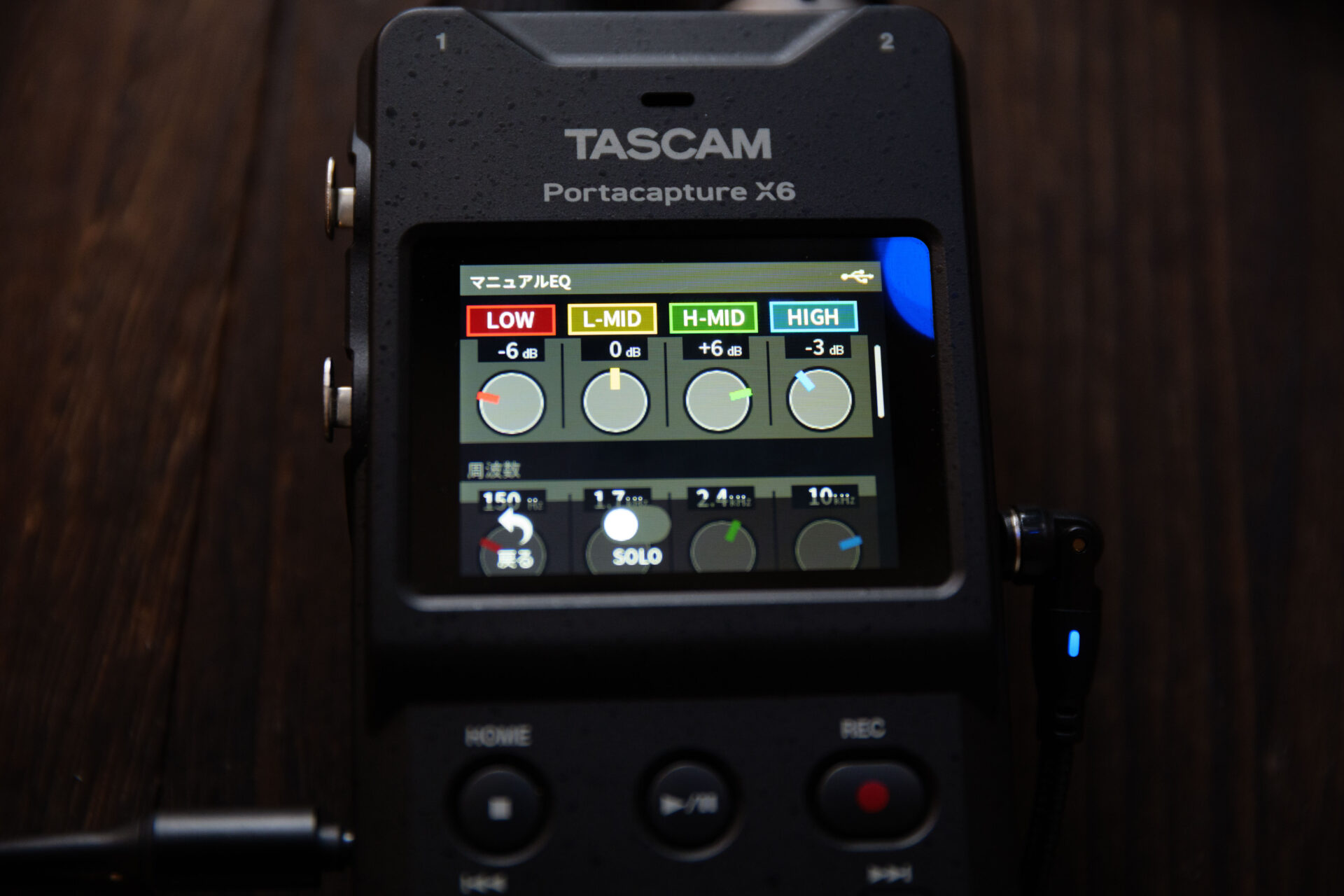
Of course, you can also make safe backup recordings (although you’ll need to restore as much of the processed sound as possible later).
It also has a preset function, so you can easily switch between them, and in an emergency, you can use it as a field recorder with an XY microphone.
However, if there are too many things I can do, I get confused and greedy, so I keep it for emergencies only.
This usage is likely to get many people angry, but please forgive me as there is no other good way to do it at the moment.
Reason for having a reference = peace of mind
Regarding the significance of monitor headphones, an interview with Yasuhiko Terada is helpful.
It’s about having a product you can trust. The reason you have a reference is because you want peace of mind.
Monitor headphones vary depending on the manufacturer and product, and not all devices will sound the same.
So you need to choose something that exceeds the standards you have set and create trust in that product.
The key is to choose headphones with a certain level of quality and let them adapt to your body, creating a reliable standard for yourself and gaining peace of mind.
If you are familiar with headphones, you will immediately notice differences in compression and EQ.
However, if you are using headphones for the first time, it may be difficult to understand.
There is no such thing as a perfect reference, but if you don’t trust such an unscrupulous system, you should stop using it.
What about passive noise canceling?
The only improvements I’ve made are EQ and phase inversion, but I’ve tried using noise-canceling headphones for monitoring, and have started putting them into practice.
As long as I use it at my workplace, I haven’t had any problems so far.
In the first place, I rarely use headphones.
It is questionable whether it is necessary to go through such trouble.
There are passive noise-cancelling headphones that claim to have high sound isolation , and everyone has been using them for a long time.
Due to their structure, these are not good at cutting low frequencies (especially unable to attenuate frequencies below 100Hz), are large in mass, and have strong lateral pressure.
On the other hand, it has advantages in high-frequency attenuation and quick sounds (plosive sounds, etc.), and of course there is no need for battery management.
In recent years, HN-7506 and UltraPhones with custom earmuffs have also appeared.
UltraPhones weighs around 400g and claims a 29db reduction.
These probably combine hearing protection (earmuffs) and monitor headphones, sold by companies like 3M.
Earmuffs PELTOR H10A attenuate 22db at 125Hz and 38db at 1kHz.
make your own headphones
It is possible to make your own if you gather the materials, but you should handle untested products with caution.
Alternatively, it is much easier to use high-quality sound-isolating earphones
, which cut out low to high frequencies easily. Monitor earphones from companies like Etymotic, Shure, and Audio-Technica are constructed like earplugs and have excellent sound isolation.
Etymotic ER4P is an earphone with extremely good sound isolation, and it shows better results than the ANC of the WH1000XM3 (roughly 32db attenuation across the entire range).
I also keep it in my bag as a backup monitor.
However, the effects of the ear canal and air pressure, the comfort of wearing them, contact noise (although Shure can reduce this considerably), the hassle of putting them on and taking them off, and the lack of familiarity with equipment that you don’t usually use…
There are disadvantages such as.
And since it tends to make the noise louder (I think), I try not to wear it as much as possible.
Display according to standards
Unlike hearing protection
, ANC headphones are just a tool for listening to sound. Therefore, there is no clear standard-based display regarding noise reduction.
Summary of current situation
I want to protect my hearing
- Prolonged exposure to loud noises can lead to hearing loss
- Headphones have a significant negative impact on hearing, and earphones may have even more problems *Uncertain
- When using monitor headphones, you want to lower the volume as much as possible.
- By reducing environmental sounds, masking can be reduced and the playback volume can be lowered (isolation).
- This time, as a method of isolationANCI decided to try
Optimized as monitor headphones
- I chose WH-1000XM3 due to ANC performance and delay issues.
- Adjusting with EQ brings the sound quality within an acceptable range.
- There are no problems with localization or sound field.
- Need to address phase issues in live sound recording
Advantages and disadvantages of active noise canceling headphones (compared to passive)
- Many are lightweight and easy to carry around. My head doesn’t feel heavy.
- Many have weak lateral pressure and are comfortable to wear. There is very little contact noise between the device and the wearer.
- Easy to cancel bass range
- Not good at canceling high frequencies
- Cannot protect against plosive sounds, etc.
- There are no devices designed for monitoring purposes (structurally unsuitable)
- Battery management required
Although I got sidetracked in various ways, I was able to reap some rewards.
In the future, while using the system I created this time, I will also compare and evaluate powerful passive noise canceling headphones.
We will also conduct training to reduce the volume when using earplug-type earphones.
I think it’s worth trying out various products for people who want to protect their ears and brain.
Other references
Noise Disorder Prevention Study Group » Listening to music using headphones/earphones


